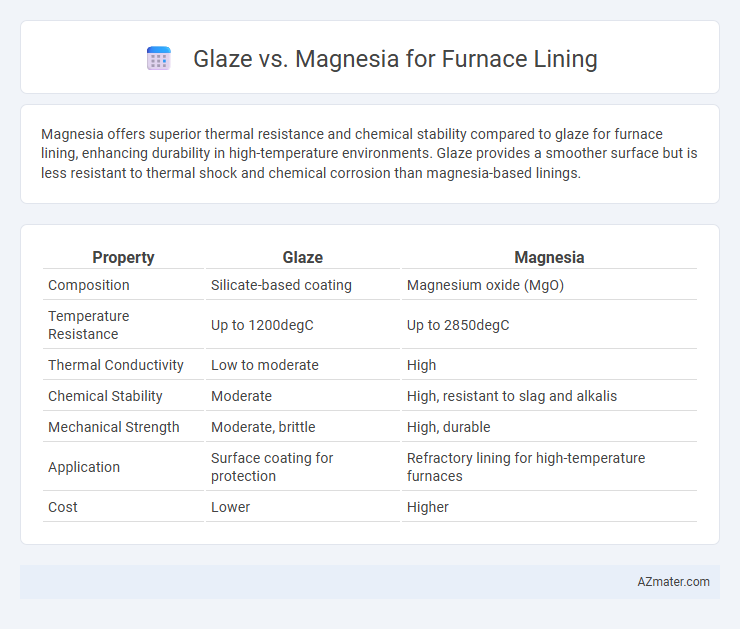Magnesia offers superior thermal resistance and chemical stability compared to glaze for furnace lining, enhancing durability in high-temperature environments. Glaze provides a smoother surface but is less resistant to thermal shock and chemical corrosion than magnesia-based linings.
Table of Comparison
| Property | Glaze | Magnesia |
|---|---|---|
| Composition | Silicate-based coating | Magnesium oxide (MgO) |
| Temperature Resistance | Up to 1200degC | Up to 2850degC |
| Thermal Conductivity | Low to moderate | High |
| Chemical Stability | Moderate | High, resistant to slag and alkalis |
| Mechanical Strength | Moderate, brittle | High, durable |
| Application | Surface coating for protection | Refractory lining for high-temperature furnaces |
| Cost | Lower | Higher |
Introduction to Furnace Lining Materials
Furnace lining materials such as glaze and magnesia play crucial roles in thermal insulation and structural stability in high-temperature environments. Magnesia, consisting primarily of magnesium oxide (MgO), offers excellent refractory properties with high melting points and chemical stability, making it ideal for steelmaking furnace linings. Glaze, typically a glassy or vitrified coating, provides enhanced wear resistance and corrosion protection, extending the lifespan of furnace linings in aggressive operational conditions.
Overview of Glaze and Magnesia Linings
Glaze linings in furnaces provide a smooth, glass-like surface that enhances corrosion resistance and reduces slag adhesion, making them ideal for high-temperature environments with aggressive molten materials. Magnesia linings consist primarily of magnesium oxide, offering excellent thermal conductivity and strong resistance to basic slags, which enhances furnace longevity under extreme thermal and chemical stress. Both glaze and magnesia linings are selected based on operational conditions, with magnesia preferred for its refractoriness and glaze for its surface protection properties.
Chemical Properties: Glaze vs Magnesia
Glaze coating for furnace lining primarily consists of silica and alumina compounds that create a glassy, impermeable barrier resistant to slag and thermal shock. Magnesia (magnesium oxide) exhibits high melting points above 2800degC and excellent chemical stability, enabling it to withstand aggressive slags and maintain structural integrity in high-temperature environments. The chemical inertness of magnesia prevents it from reacting with acidic slags, whereas glaze coatings provide a protective layer that reduces corrosion but may degrade under extreme alkaline conditions.
Thermal Resistance and Durability Comparison
Glaze furnace linings offer moderate thermal resistance with surface protection that reduces slag adhesion but tend to degrade faster under high thermal cycling. Magnesia linings provide superior thermal resistance due to higher melting points and excellent durability, maintaining structural integrity in extreme temperatures and aggressive environments. The enhanced refractoriness and corrosion resistance of magnesia make it the preferred choice for long-lasting furnace linings in steelmaking and other high-heat industrial processes.
Performance in High-Temperature Environments
Glaze and magnesia linings differ significantly in their performance in high-temperature environments, with magnesia exhibiting superior thermal resistance and chemical stability at temperatures exceeding 1600degC. Magnesia linings offer enhanced slag resistance and maintain structural integrity under intense thermal cycling, making them ideal for furnaces used in steelmaking and other metallurgical processes. Glaze linings, while providing a smooth surface and some thermal insulation, tend to degrade faster under extreme heat, reducing their lifespan in high-temperature applications.
Installation Processes: Glaze vs Magnesia
Glaze lining installation involves applying a molten glass-like coating that requires precise temperature control to form a smooth, protective surface in the furnace. Magnesia lining installation demands careful placement and compaction of magnesite bricks or castables, often requiring preheating and gradual temperature ramp-up to avoid thermal shock. Both methods necessitate skilled labor and adherence to safety protocols, but magnesia linings typically require more extensive curing and drying times compared to glaze coatings.
Cost-Effectiveness and Maintenance
Magnesia furnace linings offer high durability and superior resistance to thermal shock, reducing maintenance frequency and overall downtime, which enhances cost-effectiveness for high-temperature industrial applications. Glaze linings, although initially less expensive, tend to wear faster and require more frequent repairs, leading to higher long-term maintenance expenses. Choosing magnesia balances upfront investment with extended service life, minimizing total operational costs.
Applications in Industrial Furnaces
Glaze coatings enhance furnace lining durability by providing a smooth, glass-like surface that resists slag corrosion and thermal shock in high-temperature environments such as glass melting and steel production furnaces. Magnesia linings, composed primarily of magnesium oxide, offer exceptional refractory properties including high melting points and excellent resistance to basic slags, making them ideal for applications in electric arc furnaces and cement kilns. Selecting between glaze and magnesia depends on the furnace's operational temperature, slag chemistry, and maintenance requirements, with magnesia favored for alkaline slag environments and glaze suited for extending lining lifespan under corrosive conditions.
Environmental Impact and Sustainability
Glaze linings in furnaces typically contain glassy coatings that reduce wear but may release volatile organic compounds during manufacturing, impacting air quality. Magnesia linings, composed mainly of magnesium oxide, offer high thermal resistance and are more environmentally sustainable due to their lower emissions and recyclability after furnace life. Choosing magnesia contributes to reduced carbon footprint and aligns better with green manufacturing practices in heavy industries.
Selecting the Right Lining: Glaze or Magnesia?
Selecting the right furnace lining involves comparing glaze and magnesia for durability and thermal resistance. Magnesia linings provide high refractoriness and excellent resistance to basic slags, making them ideal for steel-making furnaces, while glaze linings offer enhanced protection against chemical attack and improved surface smoothness. Evaluate factors such as operating temperature, slag composition, and furnace atmosphere to determine the optimal lining material that ensures longevity and operational efficiency.

Infographic: Glaze vs Magnesia for Furnace Lining
 azmater.com
azmater.com